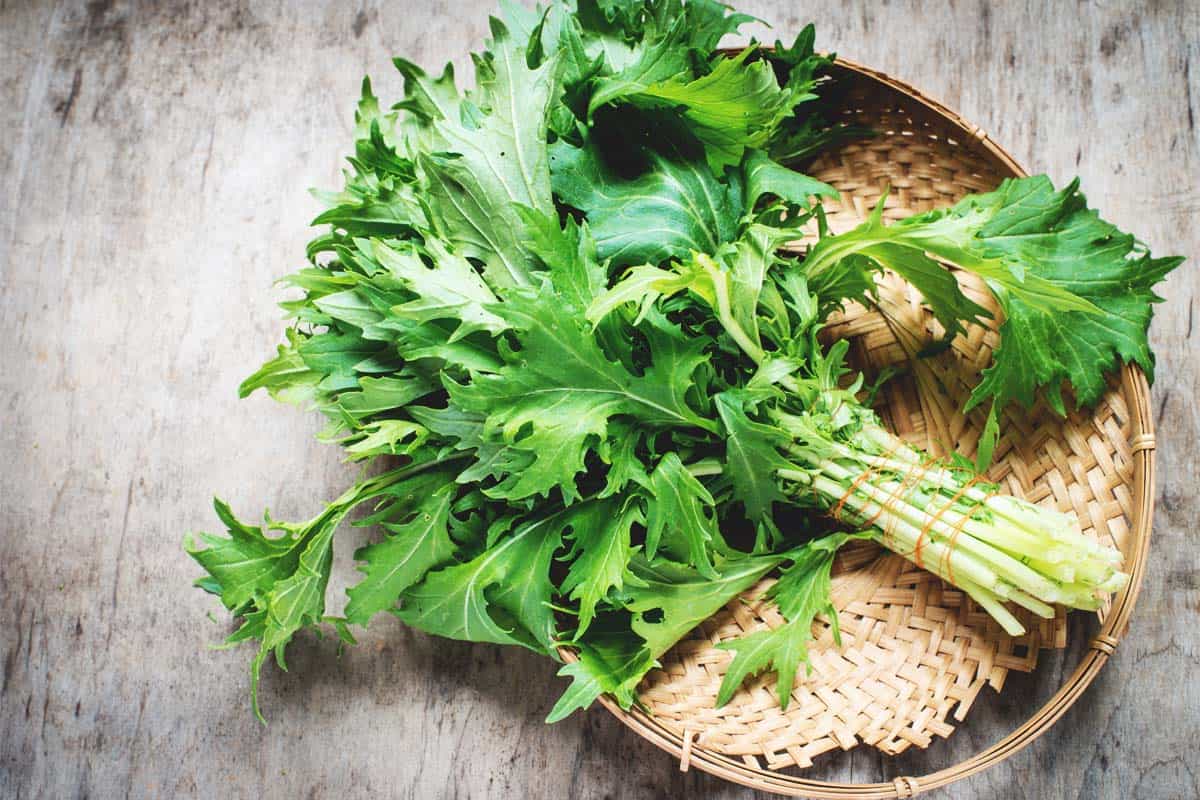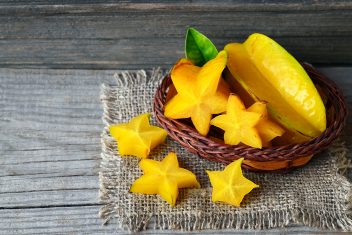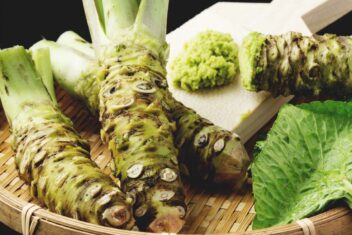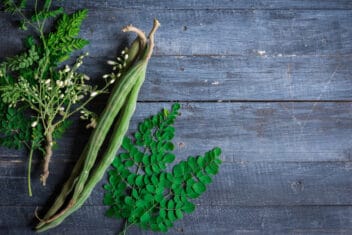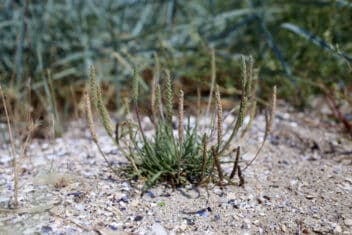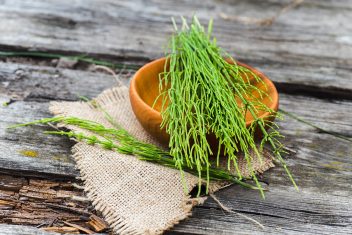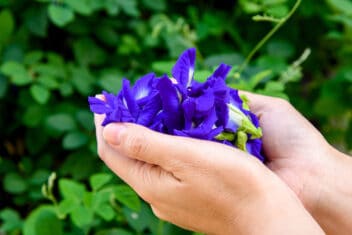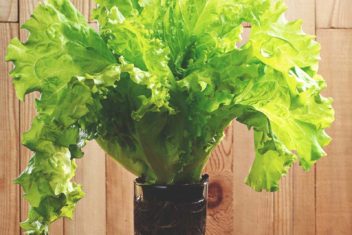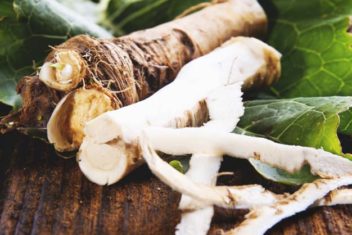Mizuna greens are a Japanese varietal of mustard greens. It’s a part of the Brassica family and is also known as Japanese Mustard or California peppergrass. It’s tough to find mizuna at a regular supermarket (unless you’re in Japan), which is one of the top reasons to consider growing mizuna greens at home.
What’s another reason to consider adding this spicy green to your garden? They’re similar in appearance to arugula, with pretty feathery, frilly green leaves and they require little maintenance in the garden. Mizuna greens are also ideal for cold weather regions and winter harvesting.
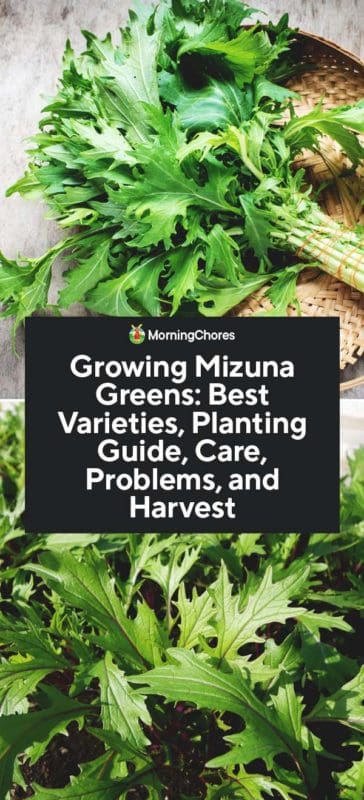
Mizuna Green Varieties
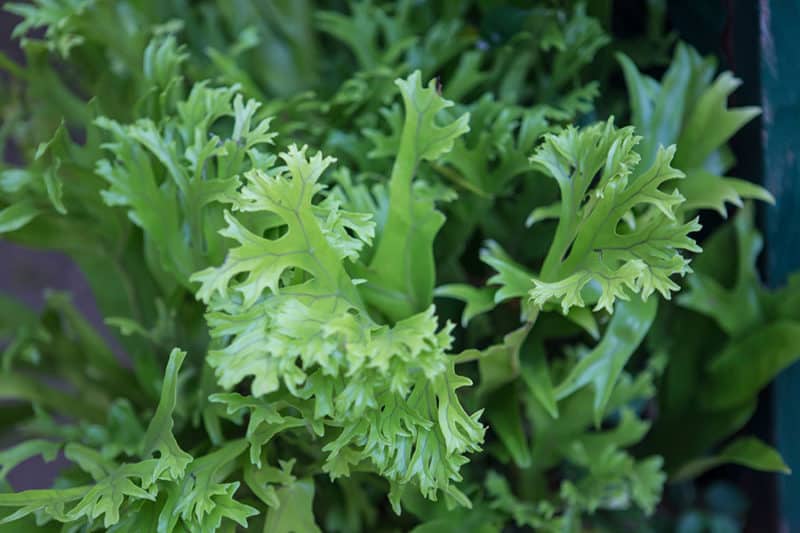
There are several mizuna types available, including the following:
- Komatsuna: Dark leaves with exceptional heat and disease tolerance. There’s also a red komatsuna variety.
- Beni Houshi: A purple stemmed mizuna packed with antioxidants.
- Japanese pink: A purple-pink stemmed variety that’s high in antioxidants and vitamin C.
- Kyona: Slim-stemmed mizuna variety.
- Vitamin Green: Deep green leaves with excellent tolerance to heat and cold.
- Early: A narrow-leaved variety with bright green leaves.
Planting Mizuna Greens
You’ll usually find mizuna greens growing as an annual, though it’s possible to overwinter mizuna, which is technically a biennial.
Mizuna won’t bolt as readily as other heat-sensitive greens, but it’s still prone to bolting, nonetheless. Extreme heat speeds up the process, so plan your planting accordingly.
Growing Zones
Mizuna greens grow well in zones 4-9.
Sun Requirements
Mizuna is highly tolerant of part shade and benefits from cover in ultra hot summer weather. It should get about 3-5 hours of sun a day in cooler weather.
Soil Requirements
This spicy veggie can grow in sandy or loamy soil, so long as it’s well-drained. Aim for pH between 6.5-7.0. Add plenty of rich organic matter when planting.
Starting Indoors
Mizuna is a fast-growing plant and tolerates a host of conditions, so it’s not always necessary to start it indoors. You can sow seeds inside before your last frost date to get a jumpstart, but it’s not necessary.
If you wish to start seeds indoors, start them at least 4 weeks before the last frost date in the spring. Start 6-12 weeks before the first frost date in fall. Transplant when seeds are a few inches tall, giving them about a week to harden off.
Direct Sowing Seeds
To sow directly in the garden, wait until after the chance of frost has passed – about two weeks after the average frost date will do in most regions.
Spacing

Thin seedlings to about 6-inches apart. Don’t waste those thinnings – you can use the thinnings in a salad or as a sandwich topper. Plant seeds 1/4-inch deep.
Caring for Mizuna Greens
Watering
Water evenly. Mizuna greens like consistently moist soil.
Mulching
Mulch around the base of plants to conserve moisture and keep the environment cool to prevent premature bolting.
Fertilizing
If your soil is healthy and rich in organic matter, you shouldn’t have to worry about adding fertilizer. Mizuna matures quickly, so fertilizing isn’t typically required.
Succession Planting
For a steady supply of mizuna greens, sow in two-week intervals in the spring and again at the tail end of the summer.
Problems and Solutions to Growing Mizuna Greens
In all my years growing mizuna greens (it’s a must-grow in my garden!), I’ve barely ever had problems. Mizuna is low-maintenance and rarely encounters pest or disease issues.
One of the reasons I love mizuna is that it’s one of the only brassica family vegetables that doesn’t attract cabbage moths. I’ve never had to pick off caterpillars from my mizuna plants.
Aphids
What plant don’t aphids love? Check out our guide to identifying and controlling this pernicious pest when growing mizuna greens.
Flea Beetles
Flea beetles are a potential problem for any brassica, but they’re more likely in gardens with low-quality, unhealthy soil. Row covers can keep away pests like these should they attack your plants.
Slugs and Snails
Slugs love to dine on young mustard greens. Use your favorite snail control method to get rid of them.
Damping Off
Mizuna greens can be prone to damping off, which is when seedlings die after being attacked by mold or fungus. Seedlings may seem soft and weak and may turn brown or grey. Or seeds may not germinate at all.
Use clean, sterilized tools, soil, and containers when planting, since the disease spreads easily. Don’t fertilize seedlings and water them with warm, not cold, water.
Bolting
Early bolting is an issue in places with hot summers, but picking the right variety is vital to avoid premature bolting. I’ve had success in planting bolt-resistant varieties in my zone 5A garden.
Companion Planting for Mizuna Greens
Mizuna can be planted near most garden plants and does well interplanted with more demanding crops.
The following are friends of mizuna greens:
- Carrot
- Lettuce
- Celery
- Onion
- Corn
- Peas
Avoid growing mizuna greens next to:
- Sunflowers
- Beans
- Strawberries
- Soybeans
Harvesting Mizuna
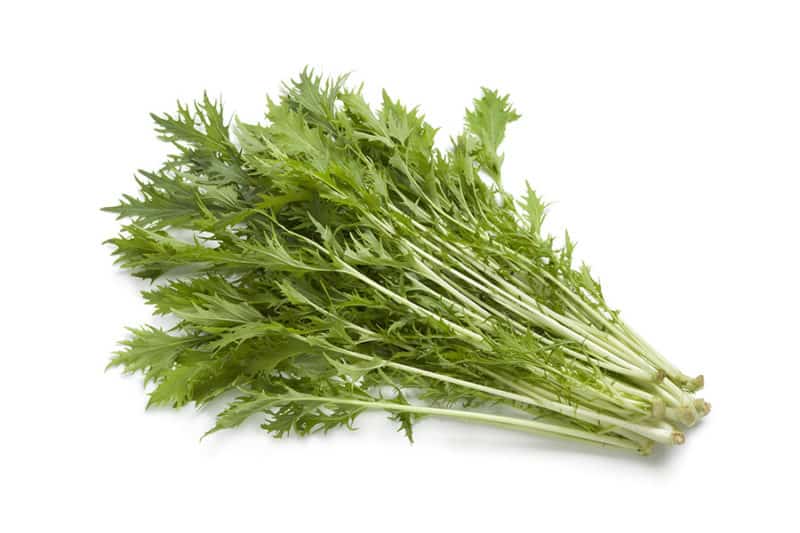
Mizuna is a cut-and-come-again crop, so feel free to keep harvesting it as it grows back. You’ll get a few harvests from a single plant, just be careful not to cut too much from one plant at a time.
Once the plant starts to send out flowers, it’s time to pull it from the garden (or leave it to self-sow). A bolted mizuna plant tastes bitter and unpalatable.
Harvest mizuna at any stage. Whenever the leaves look big enough for your tastes, cut them as needed. Usually, leaves are ready for harvest between 20 to 40 days after germination.
Cooking Mizuna
The most straightforward way to use mizuna greens is in a salad. Mizuna greens are an excellent substitute for arugula. If you’re struggling to put together a decent summer salad because your arugula bolts as soon as the summer heat comes along, try growing mizuna greens, which have less of a tendency to go to seed than arugula when exposed to high temperatures.
Mizuna is also a great addition to pasta dishes, stir-fries, and saute recipes.
My favorite way to utilize mizuna greens is to add them to soups—yes, even in the summer! I added them at the end of the cooking process then blitz the soup with an immersion blender to incorporate the nutrient-rich greens.
Here are a few recipes to consider next time you harvest a bundle of mizuna greens:
Andrea from Dishing Up the Dirt’s recipes are some of my favorites. If you’re hunting for veg-centric farm-to-table recipes, you need to check out her website, Instagram, and cookbook. This garlicky roasted potatoes recipe, which uses mizuna to add a zippy spice to the dish, is a creative take on a traditional potato salad and makes a great summertime lunch.
Mizuna and bacon go super well together, so there’s no surprise this isn’t the only recipe featured that pairs the two. This is a tasty way to incorporate freshly picked mizuna into your diet.
I’m always telling people how much I love to grow Asian vegetables because my local grocery store doesn’t always have the veg I like to cook with, mizuna especially. This tasty stir fry is easy to make and simple to customize. Want more protein? Add shrimp or chicken to the mix.
This is a simple salad that works well as a side for fatty cuts of meat like pork chops or chicken thighs. The mizuna brings the spice, the apple brings the sweetness, and the sunflower seeds and cranberries bring texture to the whole shebang.
You Should Be Growing Mizuna Greens
If the flavor and ease of growing mizuna greens doesn’t convince you to have these pretty leaves in your garden, maybe this will do the trick:
Mizuna greens are packed with vitamins like vitamin A and beta carotene. They’re also full of antioxidants, which are thought to reduce the spread of cancer cells and reduce inflammation. In addition, mizuna contains vitamin C, which helps keep the immune system in tip-top shape.
